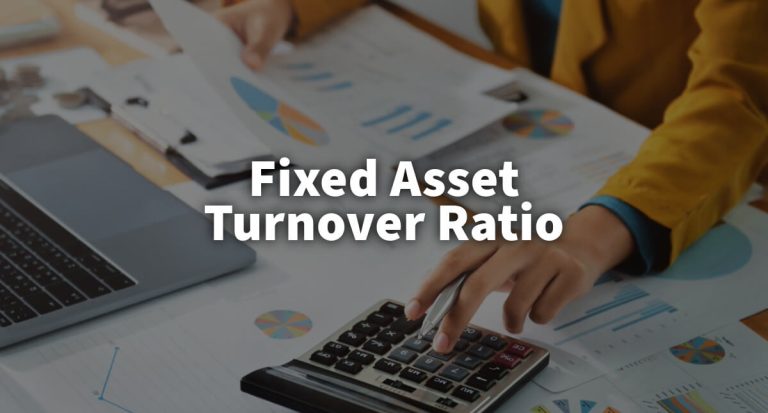What is Fixed Asset asset Ratio and How to Calculate it?
Understanding how efficiently a company uses its fixed assets to produce revenue is crucial for assessing its financial health. The fixed asset turnover ratio, a key figure found in financial statements, provides this insight.
What Is the Fixed Asset Turnover Ratio?
The fixed asset turnover ratio measures how well a company uses its fixed assets to generate sales. It tells you how effectively the company turns investments in fixed assets into revenue. A high ratio indicates efficient use of assets to produce sales.
It evaluates the effectiveness of long-term investments in assets, such as machinery and buildings, highlighted on the balance sheet, in generating sales.
This ratio, derived from net sales and net fixed assets, offers a clear view of a company’s operational efficiency.
What are Fixed Assets?
Fixed assets are long-term assets a company uses in its operations, such as buildings, machinery, and equipment. These assets are vital for capital-intensive industries that require significant investments in physical assets to generate income.
Fixed Asset Turnover Ratio Formula
Calculating this ratio involves analyzing data from asset purchases and sales over a specific period.
It is an essential tool for investors and analysts seeking to understand a company’s ability to turn long-term asset investments into revenue.Besides, it showcases the significance of asset management in achieving financial success.
You calculate the fixed asset turnover ratio by dividing net sales by average fixed assets. The formula is:
FAT= Average Fixed Assets / Net Sales
Where:
Net Sales=Gross sales, less returns, and allowances
Average Fixed Assets=NABB−Ending Balance
NABB=Net fixed assets’ beginning balance
This calculation provides insight into the asset bases’ productivity.
Interpreting the Fixed Asset Turnover Ratio
A good fixed asset turnover ratio varies by industry. However, generally, a higher ratio signifies that a company efficiently uses its fixed assets to generate sales. It means the company gets more revenue from each dollar invested in fixed assets.
Fixed Asset Turnover Ratio vs. Asset Turnover Ratio
While the fixed asset turnover ratio focuses on long-term assets, the total asset turnover ratio considers all assets, including working capital. The latter gives a broader view of how a company utilizes all its resources to generate revenue.
Limitations of Using the Fixed Asset Ratio
This ratio has limitations. It doesn’t account for the age or condition of assets, which can affect their productivity. Also, it might not be as relevant for companies that aren’t capital intensive or those with significant intangible assets.
Example of Fixed Asset Turnover Ratio
Suppose a company has net sales of $100,000 and average fixed assets of $50,000. Its fixed asset turnover ratio would be 2 ($100,000 / $50,000), indicating it generates $2 in sales for every $1 invested in fixed assets.
What is a good fixed assets turnover ratio?
A good fixed asset turnover ratio depends on the industry and the company’s asset efficiency goals. Ratios greater than 1 typically indicate efficient use of fixed assets.
Is 1.5 a good asset turnover ratio?
Yes, 1.5 can be a good asset turnover ratio, showing that the company generates $1.50 in sales for every dollar invested in assets. However, it’s important to compare this ratio to industry standards.
How much fixed asset ratio is good?
A good fixed asset ratio varies by industry but generally, ratios higher than 1 indicate good asset utilization. The optimal ratio reflects a balance between using assets effectively and over-relying on them.
Can asset turnover be greater than 1?
Yes, the asset turnover ratio can be greater than 1. This occurs when a company generates more sales than the book value of its assets, indicating efficient use of assets in generating revenue.
Can Turnover ratio be more than 100?
The turnover ratio can be more than 100. This situation occurs when the sales or revenue generated by a company significantly exceeds its investment in assets.
A turnover ratio greater than 100 indicates that a company is efficiently using its assets to generate sales, often seen in companies with low asset bases and high sales volumes.
This is particularly common in service-oriented or digital businesses, where the need for physical assets is minimal compared to their revenue generation capability.
What if the asset turnover ratio is too high?
A very high asset turnover ratio might mean a company is using its assets too much. This can wear out assets faster and lead to maintenance issues. It could also limit how much the company can grow in the future. High efficiency is good, but too much can risk the company’s future growth. It’s important to find a balance.
Bottom Line
Understanding the fixed asset turnover ratio helps gauge a company’s efficiency in using long-term assets to generate sales. This measure, vital in financial analysis, highlights the company’s capability to convert investments in fixed assets into revenue. Knowing how to calculate and interpret this ratio allows for a deeper insight into a company’s operational efficiency and financial health. It stands as an essential indicator for investors and analysts aiming to assess the effectiveness of a company’s asset management strategies in achieving financial success.
The post What is Fixed Asset Turnover Ratio and How to Calculate it? appeared first on FinanceBrokerage.

